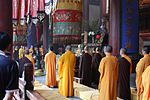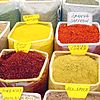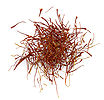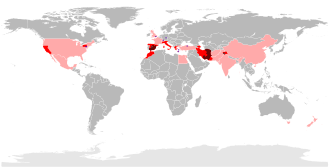- Trade and use of saffron
-
Saffron has been a key seasoning, fragrance, dye, and medicine for over three millennia.[1] One of the world's most expensive spice by weight,[2] saffron consists of stigmas plucked from the vegetatively propagated and sterile Crocus sativus, known popularly as the saffron crocus. The resulting dried "threads"[N 1] are distinguished by their bitter taste, hay-like fragrance, and slight metallic notes. The saffron crocus is unknown in the wild; its most likely precursor, Crocus cartwrightianus, originated in Crete or Central Asia;[3] The saffron crocus is native to Southwest Asia and was first cultivated in what is now Greece.[4][5][6]
From antiquity to modern times the history of saffron was fraught with applications in food, drink, and traditional herbal medicine: from Africa and Asia to Europe and the Americas the brilliant red threads were—and are—prized in baking, curries, and liquor. It coloured textiles and other items and often helped confer the social standing of political elites and religious adepts. Ancient peoples used saffron to treat stomach upsets, bubonic plague, and smallpox; modern research studies have indicated possible health benefits, which range from cancer-inhibiting[7] and allergy-moderating[8] properties to effects that combat depression[9] and promote satiety.[10]
Saffron crocus cultivation has long centred on a broad belt of Eurasia bounded by the Mediterranean Sea in the southwest to Kashmir and China in the northeast. The major producers of antiquity—Iran, Spain, Kashmir, and Greece—continue to dominate the world trade. The cultivation of saffron in the Americas was begun by members of the Schwenkfelder Church in Pennsylvania. In recent decades cultivation has spread to New Zealand, Tasmania, and California. Iran has accounted for around 90–93% of recent annual world production and thereby dominates the export market on a by-quantity basis.[11]
Contents
Modern trade
Almost all saffron grows in a belt bounded by the balmy Mediterranean in the west and mountainous Kashmir in the east. All other continents except Antarctica produce smaller amounts. In 1991, Some 300 t (300,000 kg) of whole threads and powder are gleaned yearly,[12] of which 50 t (50,000 kg) is top-grade "coupe" saffron.[13] Iran is by far the world's most important producer: in 2005 it grossed some 230 tonnes (230,000 kg) of dry threads, or 93.7% of the year's global total mass; much of the Iranian crop was bound for export.[11] In the same year, second-ranked Greece produced 5.7 t (5,700.0 kg). Morocco and the disputed[N 2] region of Kashmir, tied as the next-highest producers, each produced 2.3 t (2,300.0 kg).[11]
Thus, in decreasing order, Iran, Greece, Morocco, the Kashmir region, Azerbaijan, Morocco, and Italy dominate the world harvest. The erstwhile and northeasterly Khorasan Province, which in 2004 was divided in three, grows 95% of Iranian saffron: the hinterlands of Birjand, Ghayen, Ferdows in South Khorasan Province, along with areas abutting Gonabad and Torbat-e Heydarieh in Razavi Khorasan Province, are its key cropping areas.[14] Afghanistan has resumed cultivation in recent years; in restive Kashmir it has waned.[15] Despite numerous cultivation efforts in such countries as Austria, England, Germany, and Switzerland, only select locales continue the harvest in northern and central Europe. Among these is the small Swiss village of Mund, in the Valais canton, whose annual saffron output amounts to several kilograms.[12] Microscale cultivation occurs in Tasmania,[16] China, Egypt, France, Israel, Mexico, New Zealand, Turkey (especially Safranbolu), California, and Central Africa.[5][17]
The high cost of saffron is due to the difficulty of manually extracting large numbers of minute stigmas, which are the only part of the crocus with the desired aroma and flavour. An exorbitant number of flowers need to be processed in order to yield marketable amounts of saffron. Obtaining 1 lb (0.45 kg) of dry saffron requires the harvesting of some 50,000 flowers, the equivalent of an association football pitch's area of cultivation, or roughly 7,140 m2 (0.714 ha).[18] By another estimate some 75,000 flowers are needed to produce one pound of dry saffron.[19] This too depends on the typical stigma size of each saffron cultivar. Another complication arises in the flowers' simultaneous and transient blooming. Since so many crocus flowers are needed to yield even derisory quantities of dry saffron, the harvest can be a frenetic affair entailing about forty hours of intense labour. In Kashmir, the thousands of growers must work continuously in relays over the span of one or two weeks throughout both day and night.[20]
Once extracted, the stigmas must be dried quickly, lest decomposition or mold ruin the batch's marketability. The traditional method of drying involves spreading the fresh stigmas over screens of fine mesh, which are then baked over hot coals or wood or in oven-heated rooms where temperatures reach 30–35 °C (86–95 °F) for 10–12 hours. Afterwards the dried spice is preferably sealed in airtight glass containers.[N 3][21] Bulk quantities of lower-grade saffron can reach upwards of US$500 per pound; retail costs for small amounts may exceed ten times that rate. In Western countries the average retail price is approximately US$1,000 per pound.[5] Prices vary widely elsewhere, but on average tend to be lower. The high price is somewhat offset by the small quantities needed in kitchens: a few grams at most in medicinal use and a few strands, at most, in culinary applications; there are between 70,000 and 200,000 strands in a pound.
Experienced saffron buyers often have rules of thumb when deliberating on their purchases. They may look for threads exhibiting a vivid crimson colouring, slight moistness, and elasticity. They reject threads displaying the telltale dull brick-red colouring—indicative of old stock—and broken-off debris collected at the container's bottom, indicative of age-related brittle dryness. Such aged samples are most likely encountered around the main June harvest season, when retailers attempt to clear out the previous season's old inventory and make room for the new season's crop. Buyers recommend that only the current season's threads be used. Reputable saffron wholesalers and retailers will indicate the year of harvest or the two years that bracket the harvest date; a late 2002 harvest would thus be shown as "2002/2003".[22]
Culinary use

 Saffron rice made with bouillon cubes and saffron.Saffron is one of three key ingredients in paella valenciana.A Swedish-style saffron bun traditionally consumed before Christmas.
Saffron rice made with bouillon cubes and saffron.Saffron is one of three key ingredients in paella valenciana.A Swedish-style saffron bun traditionally consumed before Christmas.Saffron features in European, North African, and Asian cuisines. Its aroma is described by taste experts as resembling that of honey, with grassy, hay-like, and metallic notes; according to another such assessment, it tastes of hay, but only with bitter hints. Because it imparts a luminous yellow-orange hue, it is used worldwide in everything from cheeses, confectioneries, and liquors to baked goods, curries, meat dishes, and soups. In past eras, many dishes called for prohibitively copious amounts—hardly for taste, but to parade their wealth.[23]
Because of its high cost saffron was often replaced by or diluted with safflower (Carthamus tinctorius) or turmeric (Curcuma longa) in cuisine. Both mimic saffron's colour well, but have distinctive flavours. Saffron is used in the confectionery and liquor industries; this is its most common use in Italy.[24] Chartreuse, izarra, and strega are types of alcoholic beverages that rely on saffron to provide a flourish of colour and flavour. The savvy often crumble and pre-soak saffron threads for several minutes prior to adding them to their dishes. They may toss threads into water or sherry and leave them to soak for approximately ten minutes. This process extracts the threads' colour and flavour into the liquid phase; powdered saffron does not require this step.[25] The soaking solution is then added to the hot cooking dish, allowing even colour and flavour distribution, which is critical in preparing baked goods or thick sauces.[23]
Threads are a popular condiment for rice in Spain and Iran, India and Pakistan, and other countries. Two examples of such saffron rice is the zarzuela fish-seafood stew and paella valenciana, a piquant rice-meat preparation. It is likewise used in fabada asturiana, and is essential in making the French bouillabaisse, which is a spicy fish stew from Marseilles, and the Italian risotto alla milanese. The saffron bun has Swedish and Cornish variants and in Swedish is known as lussekatt (literally "Lucy cat", after Saint Lucy) or lussebulle. The latter is a rich yeast dough bun that is enhanced with saffron, along with cinnamon or nutmeg and currants. They are typically eaten during Advent, and especially on Saint Lucy's Day. In England, the saffron "revel buns" were traditionally baked for anniversary feasts (revels) or for church dedications. In the West of Cornwall, large saffron "tea treat buns" signify Methodist Sunday School outings and activities.
Moroccans use saffron in their tajine-prepared dishes, includingkefta (meatballs with tomato), mqualli (a citron-chicken dish), and mrouzia (succulent lamb dressed with plums and almonds). Saffron is key in the chermoula herb mixture that flavours many Moroccan dishes. Uzbeks use it in a special rice-based offering known as "wedding plov" (cf. pilaf). Saffron is also essential in chelow kabab, the Iranian national dish. South Asian cuisines uses saffron in biryanis, which are spicy rice-vegetable dishes. (An example is the Pakki variety of Hyderabadi biryani.) Saffron spices subcontinental beef and chicken entrees and goes into many sweets, particularly in Muslim and Rajasthani fare. Modern technology has added another delicacy to the list: saffron ice cream. Regional milk-based sweets feature it,[6] among them gulab jamun, kulfi, double ka meetha, and "saffron lassi"; the last is a spicy yogurt-based Jodhpuri drink that is culturally symbolic.
Medicinal use
Saffron's folkloric uses as an herbal medicine are legendary and legion. It was used for its carminative (suppressing cramps and flatulence) and emmenagogic (enhancing pelvic blood flow) properties.[26] Medieval Europeans used it to treat respiratory disorders—coughs and colds,scarlet fever, smallpox, cancer, hypoxia, and asthma. Other baleful targets were: blood disorders, insomnia, paralysis, heart diseases, stomach upsets, gout, chronic uterine haemorrhage, dysmorrhea, amenorrhea, infant colic, and eye disorders.[27] For the ancient Persians and Egyptians saffron was an aphrodisiac, a general-use antidote against poisoning, a digestive stimulant, and a tonic for dysentery and measles. European practitioners of the archaic and quixotic "Doctrine of Signatures" took its yellowish hue as a sign of its putative curative properties against jaundice.[28]
Initial research suggests that carotenoids present in saffron are anticarcinogenic (cancer-suppressing),[17] anti-mutagenic (mutation-preventing), and immunomodulatory. Dimethylcrocetin, the compound thought responsible for these effects, counters a wide range of murine (rodent) tumours and human leukaemia cell lines. Saffron extract also delays ascites tumour growth, delays papilloma carcinogenesis, inhibits squamous cell carcinoma, and decreases soft tissue sarcoma incidence in treated mice. Researchers theorise that, based on the results of thymidine-uptake studies, such anticancer activity is best attributed to dimethylcrocetin's disruption of the DNA-binding ability of a class of enzymes known as type II topoisomerases.[29] As topoisomerases play a key role in managing DNA topology, the malignant cells are less successful in synthesizing or replicating their own DNA.
Saffron's pharmacological effects on malignant tumours have been documented in several studies: it extends the lives of mice that are intraperitoneally impregnated with transplanted sarcomas, namely, samples of S-180, Dalton's lymphoma ascites (DLA), and Ehrlich ascites carcinoma (EAC) tumours. Researchers followed this by orally administering 200 mg (0.0071 oz) of saffron extract for each kg of mouse body weight. As a result the life spans of the tumour-bearing mice were respectively altered to 111.0%, 83.5%, and 112.5% of the baseline or reference span. Researchers also discovered that saffron extract exhibits cytotoxicity in relation to DLA, EAC, P38B, and S-180 tumour cell lines cultured in vitro. Thus, saffron has shown promise as a new and alternative treatment for a variety of cancers.[30]
Besides wound-healing and anticancer properties, saffron is also an antioxidant. This means that, as an "anti-aging" agent, it neutralises free radicals. Methanol extractions of saffron neutralise at high rates the DPPH (IUPAC nomenclature: 1,1-diphenyl-2-picrylhydrazyl) radicals. This occurred via vigorous proton donation to DPPH by two of saffron's active agents, safranal and crocin. At concentrations of 500 and 1000 ppm, crocin studies showed neutralisation of 50% and 65% of radicals, respectively. Safranal displayed a lesser rate of radical neutralisation than crocin. Such findings give saffron extracts promise as an ingredient for use as an antioxidant in pharmaceuticals, cosmetics, and as a food supplement.[31] Saffron ingested at high enough doses is harmful—even lethal. Studies of lab animals have shown that its LD50—median lethal dose, or the dose at which 50% of test animals die from overdose—is 20.7 g/kg when delivered via decoction.[17][32] Antidepressant effects have been demonstrated.[9]
Colouring and perfumery
See also: Saffron (color)
 Buddhist monks in Hangzhou, China.At market, Turkey. The "India saffron" really is not.
Buddhist monks in Hangzhou, China.At market, Turkey. The "India saffron" really is not.Despite its high cost, saffron has been used as a fabric dye, particularly in China and India. It is in the long run an unstable colouring agent; the imparted vibrant orange-yellow hue quickly fades to a pale and creamy yellow.[33] Even in minute amounts, the saffron stamens yield a luminous yellow-orange; increasing the applied saffron concentration will give fabric of increasingly rich shades of red. Clothing dyed with saffron was traditionally reserved for the noble classes, implying that saffron played a ritualised and status-keying role. It was originally responsible for the vermilion-, ochre-, and saffron-hued robes and mantles worn by Buddhist and Hindu monks. In medieval Ireland and Scotland, well-to-do monks wore a long linen undershirt known as a léine, which was traditionally dyed with saffron.[34] In histology the hematoxylin-phloxine-saffron (HPS) stain is used as a tissue stain to make biological structures more visible under a microscope.
There have been many attempts to replace saffron with a cheaper dye. Saffron's usual substitutes in food—turmeric and safflower, among others—yield a garishly bright yellow that could hardly be confused with that of saffron. Saffron's main colourant is the flavonoid crocin; it has been discovered in the less tediously harvested—and hence less costly—gardenia fruit. Research in China is ongoing.[35] In Europe saffron threads were a key component of an aromatic oil known as crocinum, which comprised such motley ingredients as alkanet, dragon's blood (for colour), and wine (again for colour). Crocinum was applied as a perfume to hair. Another preparation involved mixing saffron with wine to produce a viscous yellow spray; it was copiously applied in sudoriferously sunny Roman amphitheatres—as an air freshener.[36]
See also
 Topics related to saffron: Saffron · History · Trade and use
Topics related to saffron: Saffron · History · Trade and useNotes
- ^ Another term that denotes the stigmas.
- ^ Most of the region's saffron is grown in the more climatically suitable "Vale of Kashmir", which is under Indian control; the far more rugged "Gilgit-Baltistan" and "Azad Kashmir" areas under Pakistani control produce lesser quantities.
- ^ Pure saffron stigmas will often be mixed with stamens to add "dead"—read: "worthless"—weight. To put it mildly, stamens have little culinary appeal but will still add the signature yellow color of saffron. Powdered saffron should be red-orange rather than yellowish in colour.
Citations
- ^ Deo 2003, p. 1.
- ^ Raghavan 2006, p. 161.
- ^ Rubio-Moraga et al. 2009.
- ^ Grigg 1974, p. 287.
- ^ a b c Hill 2004, p. 272.
- ^ a b McGee 2004, p. 422.
- ^ Chryssanthi et al. 2011.
- ^ Boskabady et al. 2010.
- ^ a b Hosseinzadeh, Karimi & Niapoor 2004.
- ^ Gout, Bourges & Paineau-Dubreuil 2010.
- ^ a b c Ghorbani 2008, p. 1.
- ^ a b Katzer 2001.
- ^ Negbi 1999, p. 2.
- ^ Kafi et al. 2006, p. 24.
- ^ Malik 2007.
- ^ Courtney 2002.
- ^ a b c Abdullaev 2002, p. 1.
- ^ Hill 2004, p. 273.
- ^ Rau 1969, p. 35.
- ^ Lak 1998.
- ^ Negbi 1999, p. 8.
- ^ Hill 2004, p. 274.
- ^ a b Hill 2004, p. 275.
- ^ Negbi 1999, p. 59.
- ^ Willard 2002, p. 203.
- ^ Park 2005.
- ^ Abdullaev 2002, p. 2.
- ^ Darling Biomedical Library 2002.
- ^ Hasegawa, Kurumboor & Nair 1995, p. 1.
- ^ Nair, Pannikar & Panikkar 1991, p. 1.
- ^ Assimopoulou, Papageorgiou & Sinakos 2005, p. 1.
- ^ Chang et al. 1964, p. 1.
- ^ Willard 2002, p. 205.
- ^ Major 1892, p. 49.
- ^ Dharmananda 2005.
- ^ Dalby 2002, p. 138.
References
Books
- Dalby, A. (2002), Dangerous Tastes: The Story of Spices (1st ed.), University of California Press (published 7 October 2002), ISBN 978-0520236745, http://books.google.com/?id=7IHcZ21dyjwC
- Grigg, D. B. (1974), The Agricultural Systems of the World (1st ed.), Cambridge University Press (published 29 November 1974), ISBN 978-0521098434
- Hill, T. (2004), The Contemporary Encyclopedia of Herbs and Spices: Seasonings for the Global Kitchen (1st ed.), Wiley (published 10 September 2004), ISBN 978-0471214236
- Kafi, M. (editor); Koocheki, A. (editor); Rashed, M. H. (editor); Nassiri, M. (editor) (2006), Saffron (Crocus sativus) Production and Processing (1st ed.), Science Publishers (published 4 January 2006), ISBN 978-1578084272
- Major, J. (1892), "A History of Greater Britain as well England as Scotland", Publications of the Scottish History Society (University Press) 10
- McGee, H. (2004), On Food and Cooking: The Science and Lore of the Kitchen, Scribner (published 16 November 2004), ISBN 978-0684800011, http://books.google.com/?id=iX05JaZXRz0C
- Negbi, M. (editor) (1999), Saffron: Crocus sativusL., CRC Press (published 23 June 1999), ISBN 978-9057023941, http://books.google.com/?id=l-QJaUp31T4C
- Raghavan, S. (2006), "Saffron", Handbook of Spices, Seasonings, and Flavorings (2 ed.), CRC Press (published 23 October 2006), ISBN 978-0849328428
- Rau, S. R. (1969), The Cooking of India, Foods of the World, Time-Life Books (published June 1969), ISBN 978-0809400690
- Willard, P. (2002), Secrets of Saffron: The Vagabond Life of the World's Most Seductive Spice, Beacon Press (published 11 April 2002), ISBN 978-0807050095, http://books.google.com/?id=WsUaFT7l3QsC
Journal articles
- Abdullaev, F. I. (2002), "Cancer Chemopreventive and Tumoricidal Properties of Saffron (Crocus sativus L.)", Experimental Biology and Medicine 227 (1), PMID 11788779, http://www.ebmonline.org/cgi/content/full/227/1/20, retrieved 11 September 2011
- Assimopoulou, A. N.; Papageorgiou, V. P.; Sinakos, Z. (2005), "Radical Scavenging Activity of Crocus sativus L. Extract and Its Bioactive Constituents", Phytotherapy Research 19 (11), PMID 16317646
- Boskabady, M. H.; Ghasemzadeh Rahbardar, M.; Nemati, H.; Esmaeilzadeh, M. (2010), "Inhibitory Effect of Crocus sativus (Saffron) on Histamine (H1) Receptors of Guinea Pig Tracheal Chains", Die Pharmazie 65 (4): 300–305, April 2010, PMID 20432629, http://www.ncbi.nlm.nih.gov/pubmed/20432629, retrieved 30 September 2011
- Chang, P. Y.; Kuo, W.; Liang, C. T.; Wang, C. K. (1964), "The Pharmacological Action of 藏红花 (zà hóng huā—Crocus sativus L.): Effect on the Uterus and Estrous Cycle", Yao Hsueh Hsueh Pao 11
- Chryssanthi, D. G.; Dedes, P. G.; Karamanos, N. K.; Cordopatis, P.; Lamari, F. N. (2011), "Crocetin Inhibits Invasiveness of MDA-MB-231 Breast Cancer Cells via Downregulation of Matrix Metalloproteinases", Planta Medica 77 (2): 146–151, January 2011, PMID 20803418, http://www.ncbi.nlm.nih.gov/pubmed/20803418, retrieved 30 September 2011
- Deo, B. (2003), "Growing Saffron—The World's Most Expensive Spice", Crop and Food Research (New Zealand Institute for Crop and Food Research) (20), archived from the original on 27 December 2005, http://web.archive.org/web/20051227004245/http://www.crop.cri.nz/home/products-services/publications/broadsheets/020Saffron.pdf, retrieved 10 January 2006
- Dharmananda, S. (2005), "Saffron: An Anti-Depressant Herb", Institute for Traditional Medicine, archived from the original on 26 September 2006, http://web.archive.org/web/20060926130959/http://www.itmonline.org/arts/saffron.htm, retrieved 10 January 2006
- Ghorbani, M. (2008), "The Efficiency of Saffron's Marketing Channel in Iran", World Applied Sciences Journal 4 (4): 523–527, ISSN 1818-4952, http://www.idosi.org/wasj/wasj4%284%29/7.pdf, retrieved 3 October 2011
- Gout, B.; Bourges, C.; Paineau-Dubreuil, S. (2010), "Satiereal, a Crocus sativus L. Extract, Reduces Snacking and Increases Satiety in a Randomised Placebo-Controlled Study of Mildly Overweight, Healthy Women", Nutrition Research 30 (5): 305–313, May 2010, PMID 20579522, http://www.ncbi.nlm.nih.gov/pubmed/20579522, retrieved 30 September 2011
- Hasegawa, J. H.; Kurumboor, S. K.; Nair, S. C. (1995), "Saffron Chemoprevention in Biology and Medicine: A Review", Cancer Biotherapy 10 (4), PMID 8590890
- Hosseinzadeh, H.; Karimi, G.; Niapoor, M. (2004), "Antidepressant Effect of Crocus sativus L. Stigma Extracts and Their Constituents, Crocin and Safranal, In Mice", Acta Horticulturae (International Society for Horticultural Science) (650): 435–445, http://www.actahort.org/books/650/650_54.htm, retrieved 23 November 2009
- Nair, S. C.; Pannikar, B.; Panikkar, K. R. (1991), "Antitumour Activity of Saffron (Crocus sativus).", Cancer Letters 57 (2), PMID 2025883
- Rubio-Moraga, A.; Castillo-López, R.; Gómez-Gómez, L.; Ahrazem, O. (2009), "Saffron Is a Monomorphic Species as Revealed by RAPD, ISSR, and Microsatellite Analyses", BMC Research Notes 2: 189, 23 September 2009, doi:10.1186/1756-0500-2-189, PMC 2758891, http://www.pubmedcentral.nih.gov/articlerender.fcgi?tool=pmcentrez&artid=2758891
Miscellaneous
- Courtney, P. (2002), "Tasmania's Saffron Gold", Landline (Australian Broadcasting Corporation), 19 May 2002, http://www.abc.net.au/landline/stories/s556192.htm, retrieved 29 September 2011
- Katzer, G. (2001), "Saffron (Crocus sativus L.)", Gernot Katzer's Spice Pages, http://www.uni-graz.at/~katzer/engl/Croc_sat.html, retrieved 11 September 2011
- Lak, D. (1998), "Kashmiris Pin Hopes on Saffron", BBC News, 11 November 1998, http://news.bbc.co.uk/1/hi/world/south_asia/212491.stm, retrieved 11 September 2011
- Malik, N. (2007), Saffron Manual for Afghanistan, DACAAR Rural Development Program, http://www.icarda.org/Ralfweb/PDFs/SaffronManualForAfghanistan.pdf, retrieved 17 September 2011
- Park, J. B. (2005), "Saffron", USDA Phytochemical Database, archived from the original on 25 September 2006, http://web.archive.org/web/20060925041750/http://www.pl.barc.usda.gov/usda_supplement/supplement_detail_b.cfm?chemical_id=140, retrieved 10 January 2006
External links
- Darling Biomedical Library (2002), Saffron, UCLA, http://unitproj.library.ucla.edu/biomed/spice/index.cfm?displayID=22
Related articles Dyeing Techniques Batik · Dyeing · Kalamkari · Katazome · Leheria · Mordant · Reactive dye printing · Resist · Ring dyeing · Rōketsuzome · Shibori · Tie-dye · TsutsugakiTypes of dyes Traditional textile dyes History Trade and use of saffron · Traditional dyes of the Scottish HighlandsCraft dyes Reference Glossary of dyeing terms · List of dyesCategories:- Saffron
- Spices
Wikimedia Foundation. 2010.









